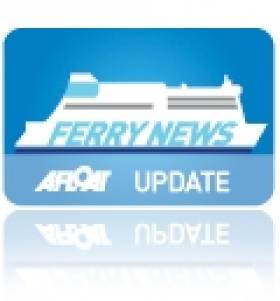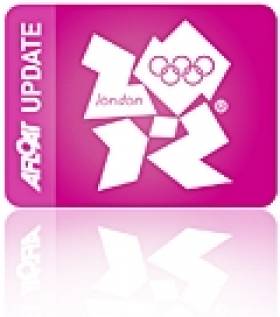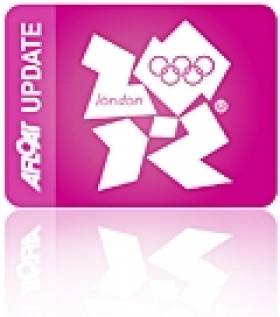Displaying items by tag: Olympic torch relay
#PORTS & SHIPPING REVIEW: Over the last fortnight Jehan Ashmore reported the shipping scene which saw President Higgins officially reopen the National Maritime Museum of Ireland in Dun Laoghaire.
The President was again on duty on the far side of Dublin Bay the next day to welcome the London Olympics 2012 Torch Relay on its first visit to the state in Howth Harbour, where the headquarters of the Olympic Council of Ireland are based.
The mid-west port of Galway was where the small German cruiseship Bremen made a port of call while at anchorage in Galway Bay.
Returning to the east coast in Dun Laoghaire Harbour, where the Water Wag's the oldest one design racing class in the world celebrate their 125 anniversary regatta week which culminates today.
Outside the harbour in Dublin Bay, the sight of a rig re-appearing was not for oil but for further preliminary work as part of the €220m Dublin Bay Project, where a new sewage pipeline outfall is to be built from Ringsend.
On the other side of the Irish Sea, the cruiseship Ocean Countess departed Liverpool City Cruise Terminal bound for Cobh. Her departure coincided on the 30th anniversary of the end of the Falklands Conflict, where in 1982, the cruiseship was used as a troopship to assist logistical operations after the 10-week long war ceased in June of that year.
Port Out Starboard Home as Olympic Torch Travels P&OSH
#OLYMPIC FERRY– With 50 days to go to the start of the London Olympic Games, the torch-relay is to depart Northern Ireland this afternoon with P&O Ferries on the North Channel service to Scotland, writes Jehan Ashmore.
Before the flame reaches the Port of Larne, 67 torch-bearers will have carried the torch today on a near 120 mile journey across the north having departed Newcastle this morning.
A highlight of the day was a water crossing on Lough Neagh, where the flame was carried by the boat Island Warrior on the largest lake on the island of Ireland. Eorann O'Neil from Crumlin had the honour of torch-bearer and the 16 year-old was nominated for his dedication to swimming.
When the torch with its accompanying escort of support vehicles arrives in Larne mid-afternoon, the flame will be taken to an event to mark it leaving Northern Ireland. An hour later the torch's motorcade is to head for the port to board the P&O conventional ferry European Highlander on the 16.30hrs sailing for Cairnryan in Galloway. The 21,188grt ferry will arrive at the port on Lough Ryan some two hours later.
Tomorrow morning sees the start of the first relay in Scotland which is scheduled to start at 06.08hrs and takes place further down along Lough Ryan at the former ferryport of Stranraer.
The ferryport closed last November when Stena Line switched Scottish ferry terminals to Cairnryan, where sailings to Belfast are still maintained by a pair of 30, 285grt 'Superfast' sisters. Close to the new €80m Stena terminal is the existing terminal that serves P&O's operations.
Tomorrow's torch returns to Cairnryan as the relay route heads northwards to Glasgow which marks the day's final destination. After the torch completes touring Scotland the relay will cross the border to England to head back to London 70 days after originally embarking on a tour of the UK and detour to Dublin. The capital has been the only location visited by the torch relay outside that of the UK and Greece.
#OLYMPIC TORCH RELAY – President Michael D.Higgins welcomed the London 2012 Olympics Torch Relay for the first time to Ireland in Howth Harbour, where the first torch-bearer Cillian Kirwin from St Fintan's High School in Sutton had the honour of running with the flame, reports Jehan Ashmore.
Kirwin, a 15 year-old cross country champion was greeted by the President. Also attending where Lord Sebastian Coe of the London Olympics, Sir Craig Reedie of the International Olympic Committee (IOC) representing Jacques Rogge, Pat Hickey President Olympic Council of Ireland (OCI) and Mayor of Fingal Cllr Gerry McGuire, aswell as Carál Ní Chuilín, Sports Minister of Northern Ireland who accompanied the relay.
Hundreds of locals, excited schoolchildren and visitors alike enjoyed the festive atmosphere at the fishing harbour where the Olympic Council of Ireland headquarters are based. Their premises formerly Howth House, built around 1807 was where the supervisor of Howth Harbour resided.
Today's historic event with its detour to the republic is part of a 70-day London torch relay tour in the UK. Earlier this morning the torch had crossed the border where it was passed between two former Olympic boxers, Belfast's Wayne McCullough and Dubliner Michael Carruth.
The President told the large crowd that the flame's arrival in Ireland symbolised the growing closeness of the relationship between the UK and Ireland. The President spoke of the Olympics "where sport builds bridges" and of friendship and fairplay.
After a brief ceremony the Olympic hymn was sung by local children from Scoil Mhuire Primary School as the flame was whisked away under Garda escort to Dublin. The torch tour included Croke Park, the Garden of Remembrance, GPO and Trinity College.
When the torch reached the Liffey, it was carried across the Samuel Beckett Bridge by former international soccer player Paul McGrath to the Grand Canal Theatre. At the same time Dublin Port Company tug sisters Shackleton and Beaufort paid a tribute by firing powerful water jets high into the sky.
The sporting spectacle drew large crowds along the bridge and office workers looked down from their quayside offices to witness the torch head for its final destination in St. Stephens' Green.
Irish team's Chef de Mission Sonia O'Sullivan became the final torch-bearer. The celebrations culminated when she performed lighting an Olympic cauldron to commemorate the visit.
RNLI To Play Big Part in Olympic Torch Relay
#OLYMPICS 2012 - The RNLI will play a "key role" during the Olympic torch relay ahead of the London games this summer, as Yachting and Boating World reports.
On 28 May the Olympic torch is set to visit Anglesey in north Wales, when it is taken along the Menai Strait on board the RNLI's Annette Mary Liddington.
The torch will again be carried by RNLI volunteers on 18 July when it is ferried to shore from a tall ship in Dover harbour aboard the all-weather lifeboat City of London II.
Dover RNLI's operations manager Roy Couzens said: “We are very much looking forward to being involved on the day – and believe me, when that torch is at sea in our lifeboat, it couldn’t be in safer hands!”
The Olympic torch relay begins in Plymouth on 19 May and finishes at the Olympic Stadium on 27 July. Its two-month-long journey will take it throughout Britain and Northern Ireland, and includes a visit to Dublin on Wednesday 6 June.
An interactive map of the complete torch relay route is available on the official London 2012 website HERE.



























































